The Ultimate Homemade Cheese Sauce: A Rich, Creamy & Easy Family Recipe for Everything!
This incredibly easy recipe for Homemade Cheese Sauce is a beloved classic that dates back generations in my family. It all started with my Great-Grandma’s foundational white sauce, a simple yet versatile base. My Mom took that cherished recipe and elevated it in the 1990s by adding cheese, transforming it into the creamy, dreamy sauce we’ve adored ever since. It’s been a staple in our kitchen for decades, perfect for enhancing everything from crisp broccoli and tender cauliflower to crispy French fries, soft pretzels, and so much more!

Like many children, I wasn’t always the biggest enthusiast for vegetables growing up. While my adult palate now appreciates a wide array of veggies prepared in various ways, there was definitely a time when getting me to eat them was a challenge. My Mom, ever the resourceful cook, embarked on a mission to find creative ways to make broccoli and cauliflower appealing. It didn’t take long for her to realize that a delicious, easy cheese sauce recipe was the secret weapon she needed.
She remembered her Grandma’s method for a basic white sauce, also known as a béchamel. With a stroke of culinary genius, she decided to incorporate a generous amount of shredded cheese into it. The result was a spectacularly tasty cheese sauce that not only made vegetables irresistible but also proved to be incredibly versatile for countless other dishes. Before I knew it, I was happily devouring my broccoli, proudly declaring it my favorite! This simple addition of cheese transformed mealtime, turning a chore into a treat.
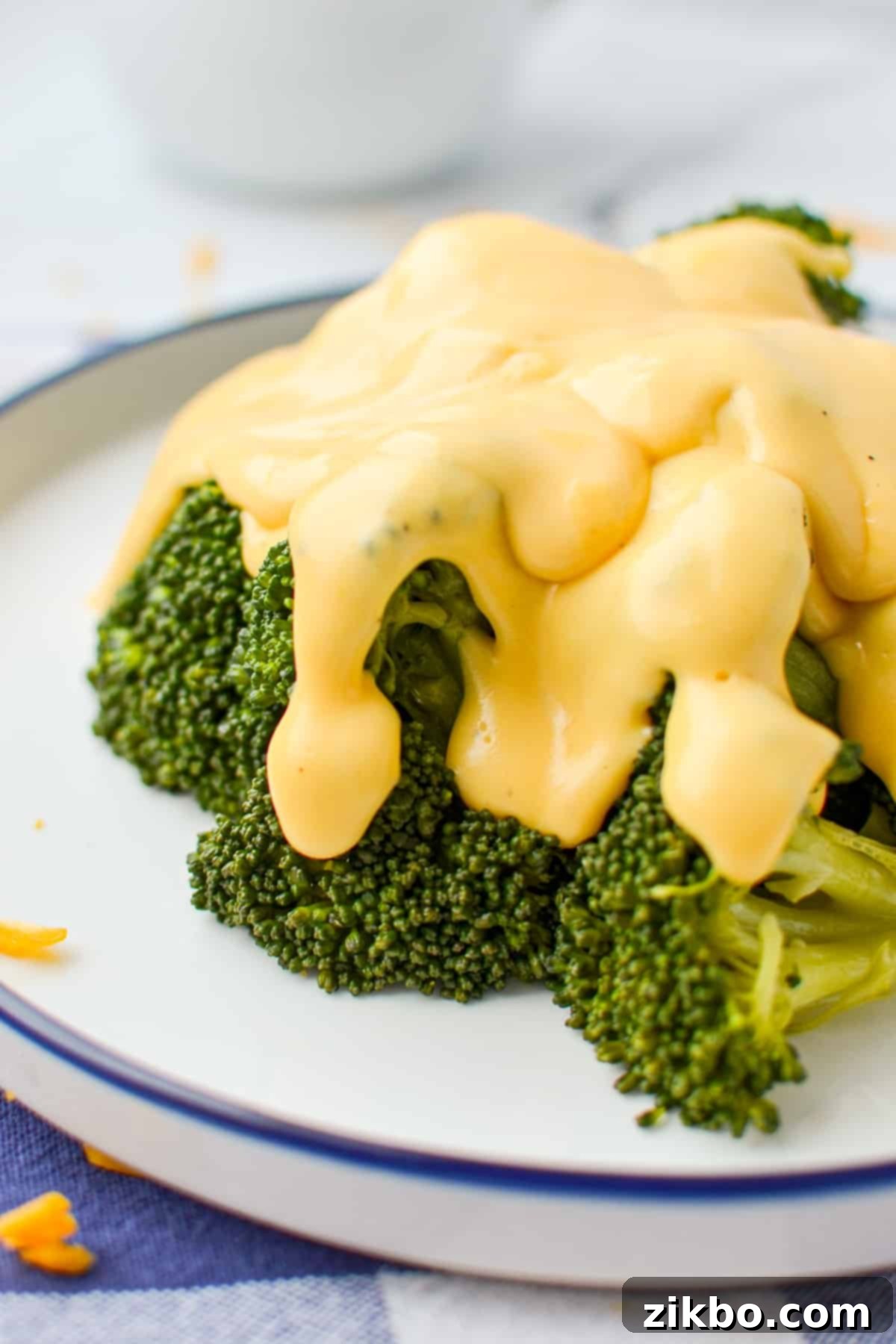
While my Mom is an excellent cook, she tends to work with intuition rather than precise measurements. Over my almost 20 years in the kitchen, I’ve refined her method, adding exact quantities and a few extra tips and tricks I’ve picked up along the way. This version ensures consistent, perfect results every time, bringing that cherished family flavor right to your table with professional precision.
Why Make Homemade Cheese Sauce From Scratch?
There are countless reasons to whip up your own creamy cheese sauce at home. Beyond just tasting incredible, making it from scratch offers a host of benefits that store-bought versions simply can’t match:
- Know Your Ingredients: When you make cheese sauce from scratch, you have complete control over what goes into it. This means no mystery ingredients, just simple, wholesome components you recognize and trust.
- Healthier & Fresher: Say goodbye to unnecessary preservatives, artificial thickeners, MSG, and potential allergens often found in pre-made sauces. Your homemade version will be naturally fresh and free from unwanted additives.
- Picky Eater Approved: While we can’t offer a 100% guarantee, a rich, savory cheese sauce is famously effective at encouraging kids (and even some adults!) to eat their vegetables. It’s the ultimate disguise for nutritious greens.
- Unmatched Versatility: This isn’t just a sauce for one dish. It’s an indispensable kitchen tool! Use it to elevate steamed or roasted broccoli and cauliflower, transform plain French fries into decadent cheese fries, create an amazing dip for soft pretzels, or serve as the foundational base for the creamiest homemade mac & cheese you’ve ever tasted. The possibilities are truly endless.
- Recipe MVP: It makes an excellent stand-in for condensed cheddar cheese soup in recipes, adding a fresh, homemade touch. For example, it works wonderfully in my Cheesy Vegetable Casserole recipe, adding depth and richness.
- Superior Flavor & Texture: Nothing beats the rich, authentic flavor and velvety-smooth texture of a cheese sauce made with real cheese and quality ingredients. It’s far creamier and more satisfying than anything from a can or jar.
- Cost-Effective: Making your own cheese sauce is surprisingly economical, especially when you consider the quality and quantity you get compared to store-bought options.
Key Ingredients for the Perfect Cheese Sauce
Crafting a truly exceptional homemade cheese sauce requires just a handful of simple, high-quality ingredients. Each plays a crucial role in achieving that coveted creamy texture and rich, cheesy flavor. Here’s what you’ll need and why:
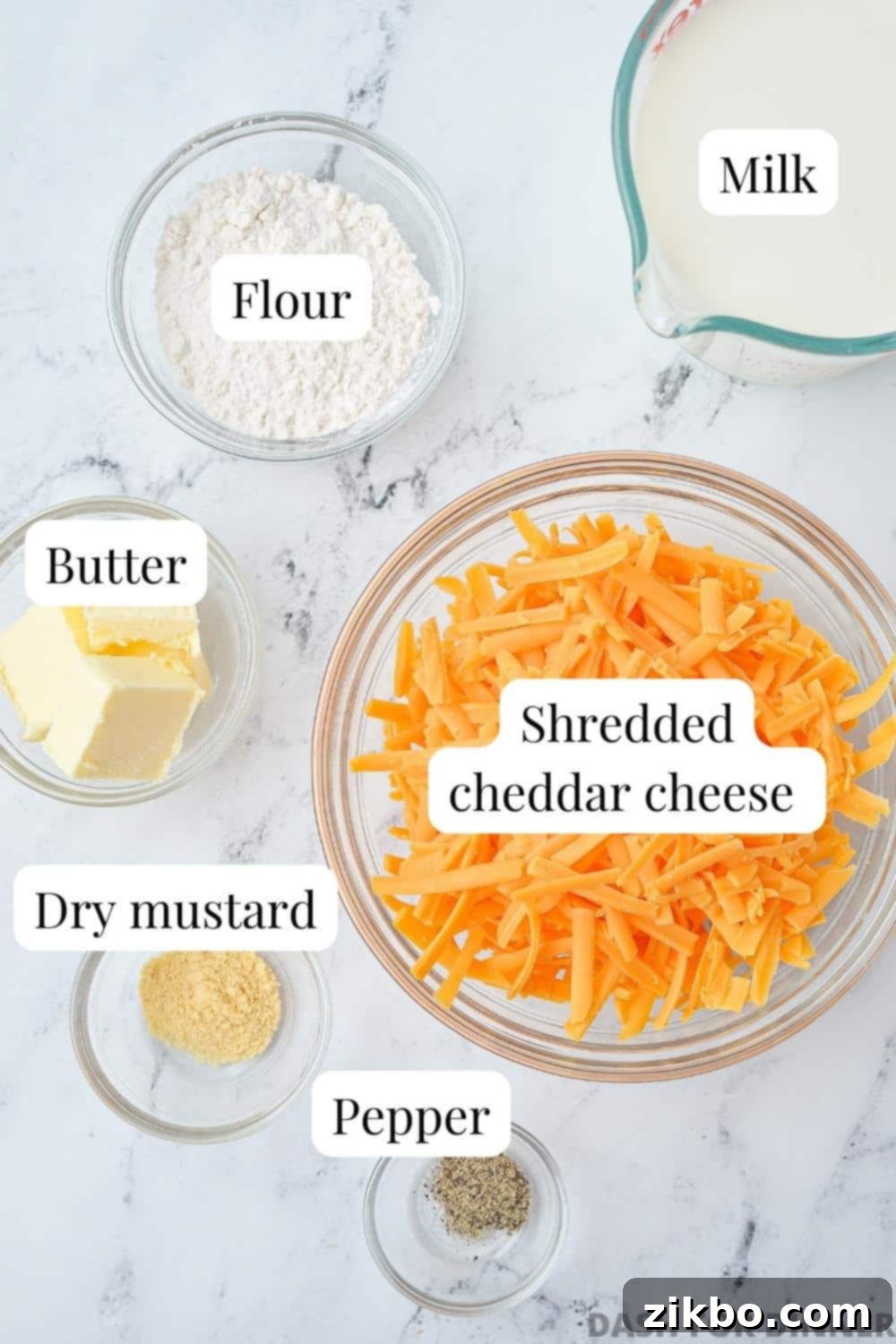
- Cheese: For the best results, I wholeheartedly recommend using a high-quality block of sharp cheddar cheese that you shred yourself. Pre-shredded cheeses are often coated with anti-caking agents like cellulose or potato starch, which can prevent them from melting smoothly, resulting in a slightly grainy or gritty texture in your finished sauce. Freshly shredded cheese melts beautifully, creating a silky, luscious sauce. Sharp cheddar offers a robust, tangy flavor that truly shines, but you can explore other cheese options for variations (see “Variations” section).
- Butter: This is the foundation of our roux, the essential thickening agent for the sauce. Butter contributes to the rich, savory flavor and helps create a smooth, emulsified base. I prefer using salted butter as it adds a touch of seasoning, but unsalted butter works perfectly well if you want to control the salt content more precisely.
- Whole Milk: Whole milk is key for achieving a rich, creamy, and decadent cheese sauce. Its higher fat content contributes to the luxurious mouthfeel and prevents the sauce from becoming thin or watery. While you can use lower-fat milk, the sauce may not be as thick or flavorful.
- All-Purpose Flour: When combined with melted butter, all-purpose flour creates the roux, which thickens the sauce to a perfect consistency. The flour acts as a binding agent, ensuring your sauce is smooth and velvety, not runny. I’ve tested unbleached, regular, and organic flours, and they all perform equally well, so use what you have on hand.
- The Secret Ingredients & Seasoning:
- Dry Mustard Powder: This is my “secret ingredient” for an extra layer of cheesy goodness! Don’t worry, it won’t make your sauce taste like mustard. Instead, it subtly enhances the natural umami and sharpness of the cheese, making it taste even more “cheesy.” It’s a game-changer!
- Black Pepper & Salt: A dash of freshly ground black pepper adds a hint of warmth and depth. Salt, of course, is essential for balancing and bringing out all the flavors. Always add salt to taste once the sauce is finished, as the saltiness of your butter and cheese can vary.
Essential Equipment
Having the right tools can make all the difference in achieving a perfect, lump-free cheese sauce. Here’s what I recommend:
- Heavy-Bottomed Saucepan: This is truly important for making a successful roux and sauce. A heavy-bottomed saucepan, ideally stainless steel or cast iron enamel, ensures even heat distribution, which is crucial for preventing scorching and burning, especially when cooking the butter and flour mixture or simmering the milk. Thinner, cheaper pans can create hot spots, leading to an unevenly cooked or burnt roux.
- Whisk: A good quality whisk is your best friend when making cheese sauce. You’ll be whisking constantly to combine the butter and flour for the roux, and then vigorously incorporating the milk to prevent lumps. I personally love using an OXO balloon whisk for its comfortable grip and ability to reach all corners of the pan, but any sturdy whisk you have on hand will work.
How to Make the Best Homemade Cheese Sauce: Step-by-Step
Making this creamy cheese sauce is a straightforward process, but paying attention to a few key steps will ensure a perfectly smooth and delicious result every time. Follow these simple instructions:
Step One: Prepare the Roux Base
Begin by heating a heavy-bottomed saucepan over medium heat. Once the pan is warm, add the butter. Swirl the pan or stir with your whisk to help the butter melt evenly and completely. Don’t let it brown too much, just melt.
Step Two: Add the Flour
Once the butter is fully melted, sprinkle in the all-purpose flour. Immediately whisk vigorously to combine the flour and butter into a smooth, thick paste. This mixture is called a roux, and it’s the magical base that will thicken our sauce.
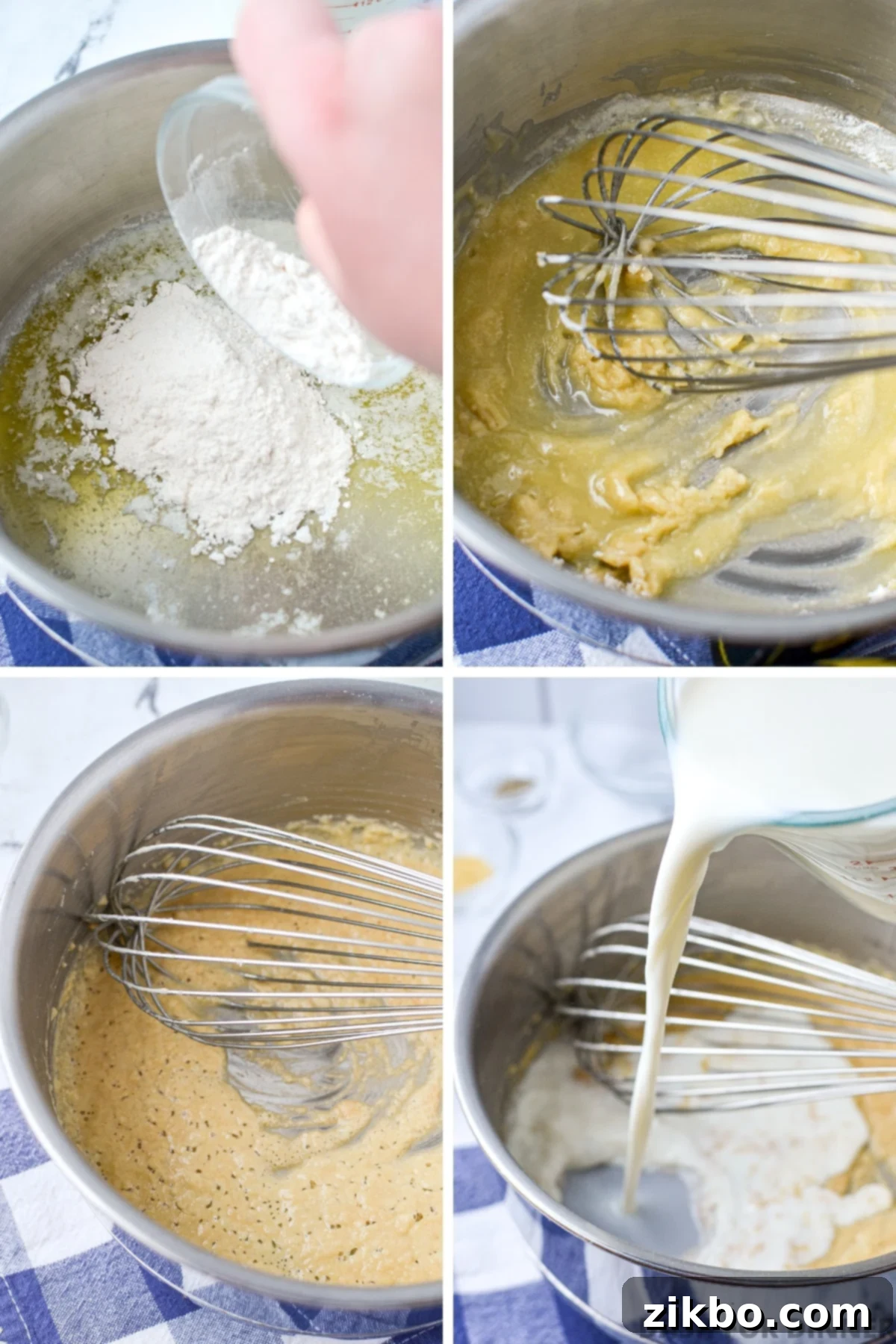
Step Three: Cook the Roux to Perfection
Continue whisking the flour and butter mixture constantly over medium heat. You’re looking for it to cook for about 2-3 minutes, until it turns a light blonde color and starts to bubble gently. This crucial step cooks out the raw flour taste, ensuring your sauce has a smooth, nutty flavor rather than a raw, starchy one. Do not rush this step, but also don’t let it get too dark.
Gradually Adding the Milk
Step Four: Incorporate the First Batch of Milk
Immediately pour in about ½ cup of cold whole milk into the hot roux. Whisk it in very well and vigorously until it is thoroughly combined and forms a very thick, smooth consistency. The contrast in temperature helps prevent lumps.
Step Five: Continue Adding Milk Gradually
Continue adding the remaining milk, about ½ cup at a time. After each addition, whisk well until the milk is fully incorporated and the mixture is smooth before adding more. This gradual process is key to a silky, lump-free sauce. If you add all the milk at once, it’s much harder to whisk out any lumps that might form.
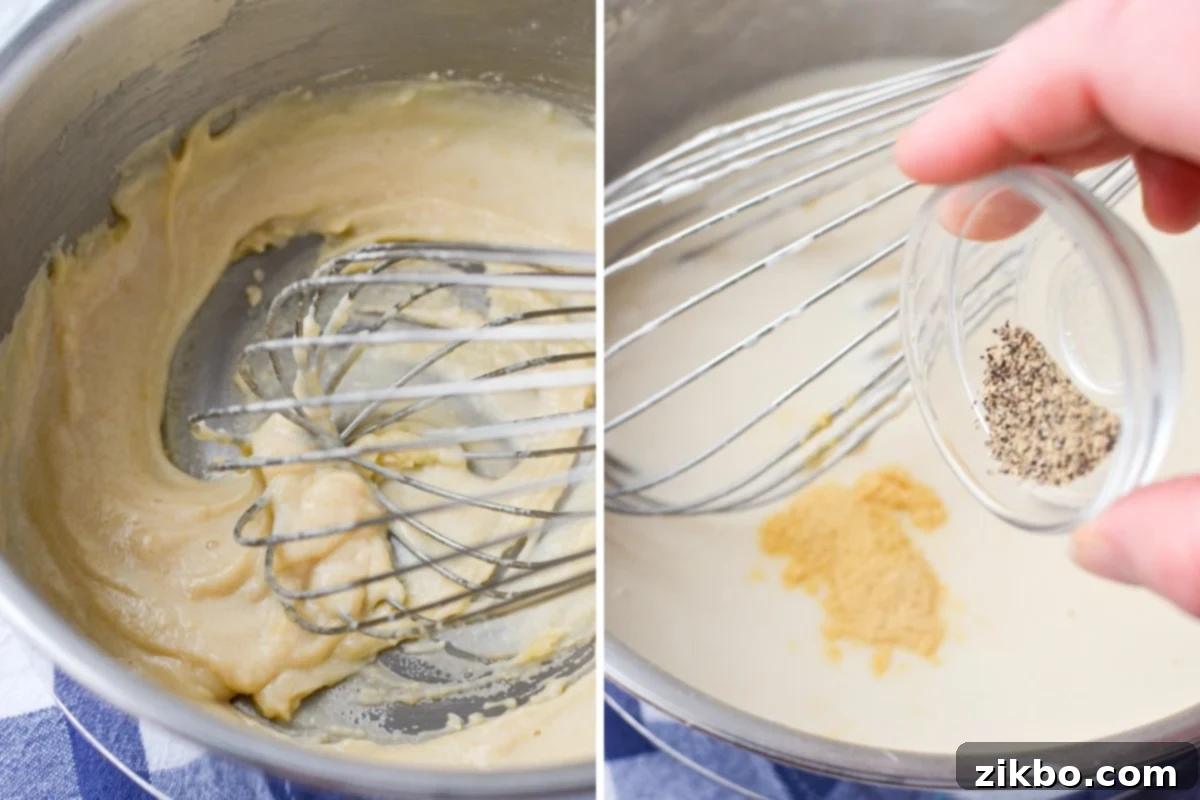
Step Six: Add the Flavor Enhancers
Once all of the milk has been successfully incorporated and the sauce base is smooth, add the ground black pepper and the dry ground mustard powder. Stir well to combine these seasonings evenly throughout the sauce. The dry mustard will work its magic subtly, enhancing the cheese flavor.
Thickening the Sauce to a Velvety Consistency
Step Seven: Simmer and Thicken
Bring the milk mixture to a low simmer over medium-low heat. Continue to cook, stirring frequently (or whisking occasionally), for about 2-3 minutes, or until the sauce has visibly thickened to your desired consistency. It should coat the back of a spoon. Be careful not to let it boil vigorously, and keep stirring to prevent it from sticking to the bottom of the pan.
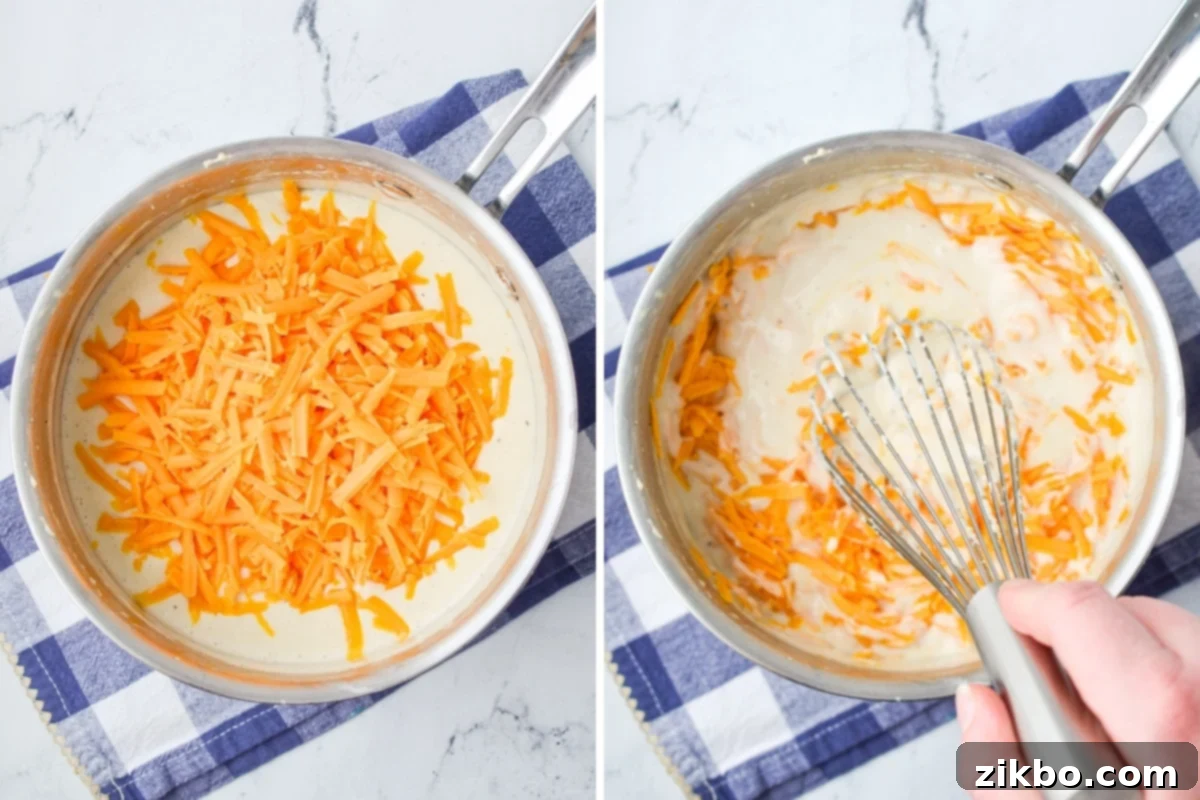
Folding in the Shredded Cheese
Step Eight: Melt in the Cheese
This is the moment of magic! Remove the saucepan from the heat immediately. Add 2 ½ cups of freshly shredded sharp cheddar cheese to the hot milk mixture. Whisk continuously until all the cheese has completely melted into a smooth, creamy, and uniform sauce. Removing it from the direct heat helps prevent the cheese from becoming oily or separating. Taste and adjust for salt and pepper as needed.

Serve your glorious homemade cheese sauce immediately and enjoy its rich, velvety goodness!
Storing and Reheating Your Homemade Cheese Sauce
Homemade cheese sauce, especially one thickened with a roux, will naturally thicken significantly as it cools. Don’t be surprised if it becomes an almost solid mass once completely chilled – this is perfectly normal!
To Store Leftovers: Allow the cheese sauce to cool completely at room temperature (this helps prevent condensation and bacterial growth). Transfer the cooled cheese sauce to an airtight container. It can be stored in the fridge for up to 4 days. For longer storage, it freezes beautifully for up to 2 months. Make sure to label and date your container.
To Reheat: Homemade cheese sauce reheats best in the microwave, using short intervals and stirring frequently. Place the desired amount in a microwave-safe dish, cover loosely, and heat on medium power for 30-60 second intervals, stirring well after each. You can also reheat it gently over low heat in a saucepan on the stovetop. The key is to stir often to prevent scorching and separation. If the sauce is too thick, you can whisk in a tablespoon or two of milk (or even water) while reheating until it reaches your desired consistency. Avoid high heat, as it can cause the cheese to separate and become oily.
Incredible Ways to Use Your Creamy Cheese Sauce
This versatile homemade cheese sauce is more than just a topping; it’s a culinary chameleon that can elevate countless dishes. Here are some of our favorite ways to enjoy its creamy goodness:
- Vegetable Lover’s Dream: Drizzle generously over steamed or roasted broccoli, cauliflower, green beans, asparagus, or a medley of your favorite seasonal veggies.
- Ultimate French Fries & Loaded Potatoes: Turn plain fries into decadent cheese fries, or pour it over baked potatoes, potato wedges, or even “funeral potatoes” for an extra layer of richness.
- Mac & Cheese Base: This sauce is the perfect foundation for a truly gourmet homemade macaroni and cheese. Just cook your pasta, drain, and stir in the warm sauce for an instant classic.
- Nacho Cheese Dip: Elevate your game day snacks! Season with a touch of cayenne pepper, garlic powder, onion powder, or even a dash of your favorite hot sauce and some diced green chilies to transform it into a spicy, authentic nacho cheese dip. Perfect for tortilla chips!
- Pretzel Perfection: Serve as a warm, inviting dip for soft pretzels or pretzel bites. The salty-sweet combination is irresistible.
- Soup & Casserole Enhancer: Use it as a rich and flavorful substitute for condensed cheddar cheese soup in various recipes, adding a homemade touch to casseroles and creamy soups.
- Quesadillas & Burritos: Add a dollop inside quesadillas or burritos for an extra layer of creamy, cheesy goodness.
- Chili Cheese Dogs & Burgers: Take your hot dogs, chili dogs, or even burgers to the next level by pouring a generous amount over the top.
- Broccoli Cheddar Soup: Thicken it slightly more and blend with steamed broccoli for a quick and easy broccoli cheddar soup.
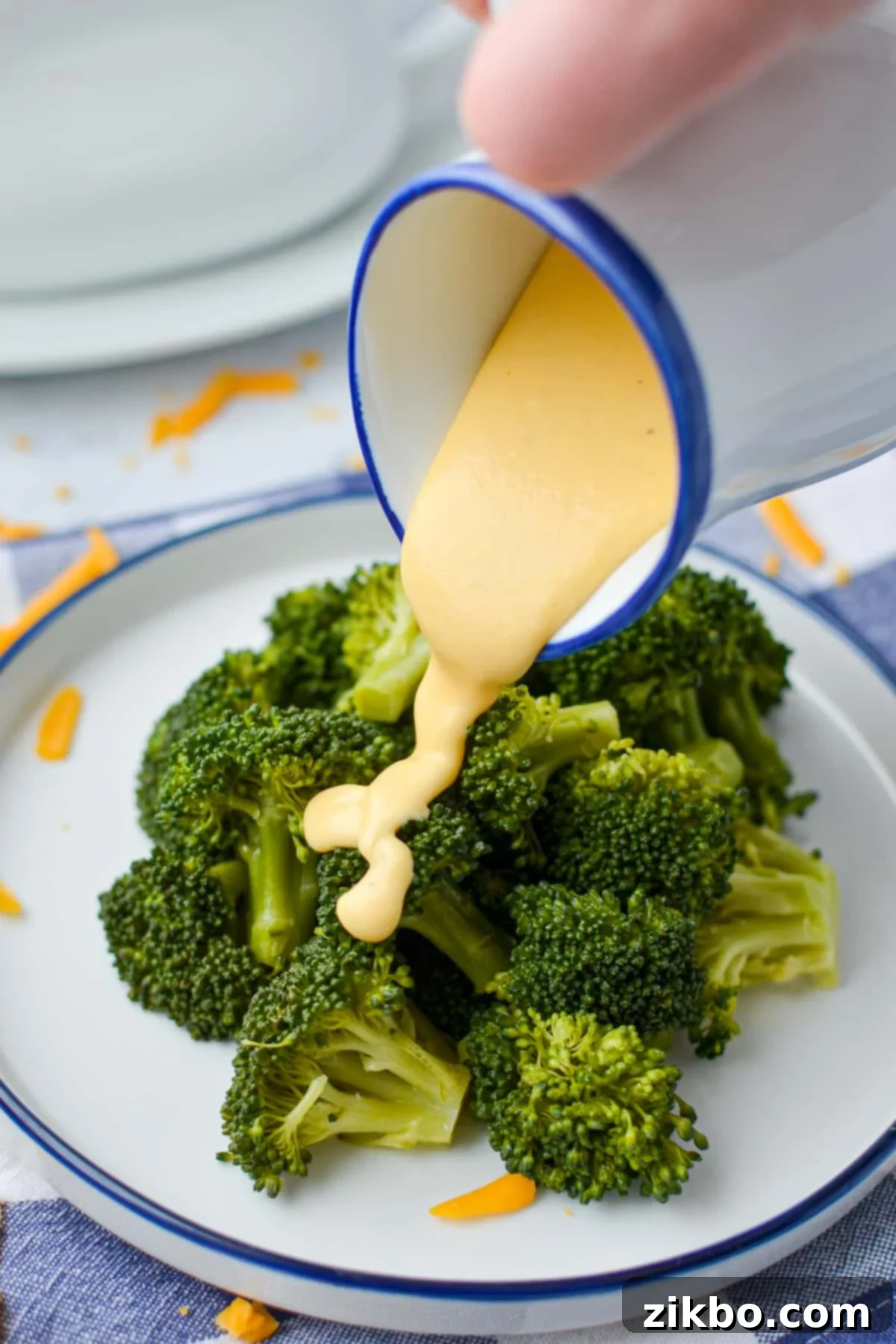
Expert Tips for the Smoothest, Most Flavorful Cheese Sauce
Achieving cheese sauce perfection is easy with these insider tips and tricks:
- Always Shred Your Own Cheese: I cannot emphasize this enough! This is arguably the most crucial tip for a perfectly smooth sauce. Pre-shredded, store-bought cheeses are typically coated with anti-caking agents like cellulose or potato starch to prevent clumping in the bag. These agents don’t fully dissolve when heated, leading to a grainy, less-than-silky texture in your sauce. Invest in a good block of sharp cheddar and grate it fresh for unparalleled smoothness and flavor.
- Cook Your Roux Properly: The roux (butter and flour mixture) needs to be cooked long enough to eliminate the raw flour taste, but not so long that it burns or darkens too much for a white sauce. Whisk constantly for 2-3 minutes over medium heat until it’s light blonde and bubbly. This imparts a pleasant, slightly nutty flavor. An undercooked roux will give your sauce a starchy, raw taste.
- Don’t Skip the Dry Mustard: Also known as ground mustard or dry ground mustard, this finely powdered spice is truly a secret weapon. It doesn’t make the sauce taste like mustard but instead magically amplifies the savory, umami notes of the cheese, making the entire sauce taste richer and more intensely “cheesy.” If you can’t find it or prefer to omit it, the sauce will still be delicious, but you’ll miss that subtle boost of flavor. It cannot be substituted with prepared yellow mustard.
- Add Cold Milk Gradually: When adding milk to the hot roux, use cold milk and add it in small increments (½ cup at a time), whisking vigorously after each addition. The temperature difference helps prevent lumps, and adding it slowly allows the flour to fully absorb the liquid, ensuring a smooth, uniform consistency.
- Melt Cheese Off the Heat: For the creamiest, silkiest sauce, always remove the saucepan from the heat before adding the shredded cheese. Stirring the cheese into a very hot, but not actively cooking, sauce prevents it from overheating, which can cause the cheese proteins to seize up, leading to a greasy, separated, or stringy texture.
- Season to Taste: The saltiness of your butter and cheese can vary, so always taste your finished sauce before adding additional salt. Adjust black pepper and salt to your personal preference for a perfectly seasoned result.
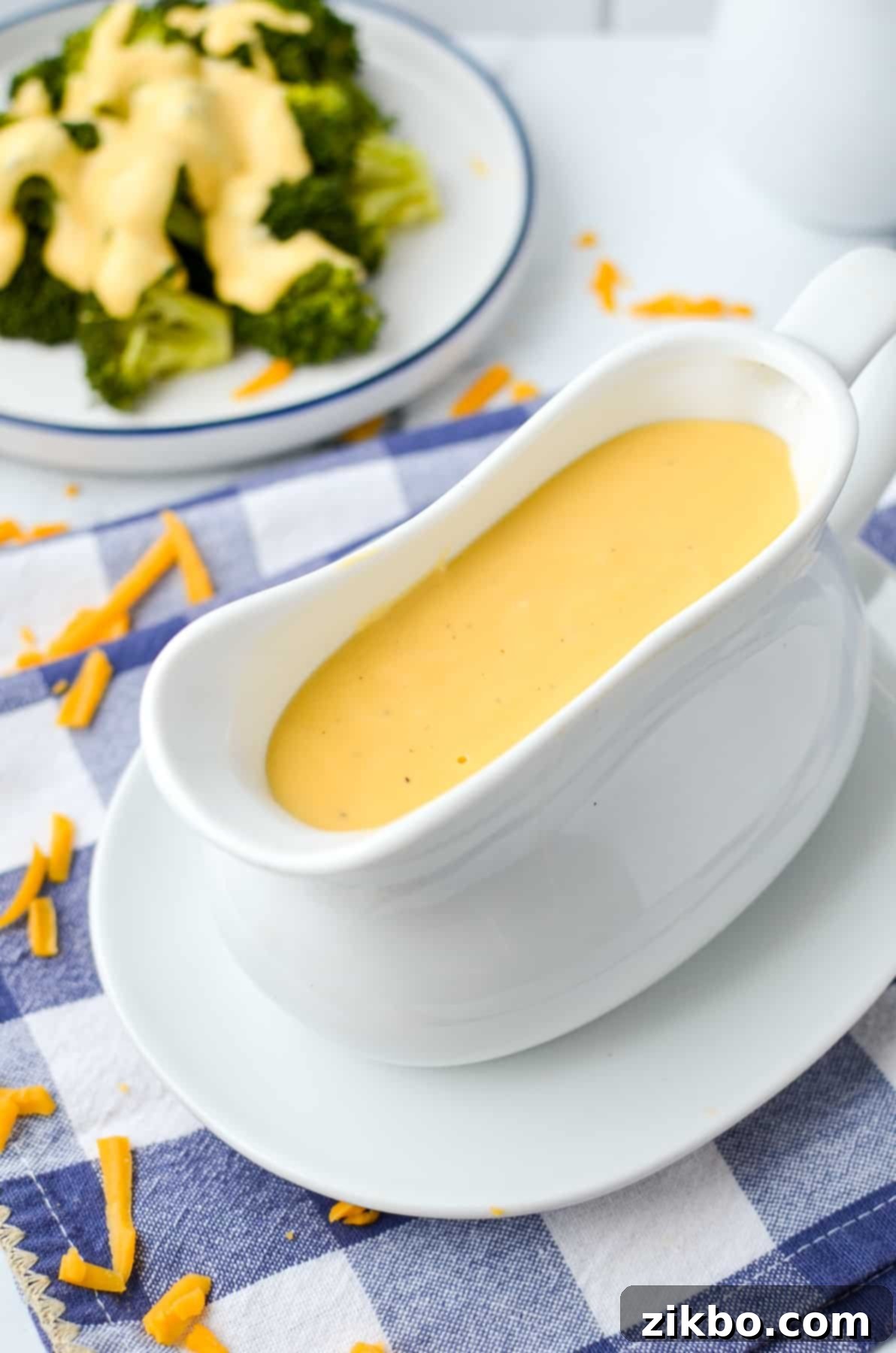
Variations and Substitutions to Customize Your Sauce
While this classic cheddar cheese sauce is perfect as is, it’s also incredibly adaptable. Feel free to experiment with these variations and substitutions to tailor it to your taste or dietary needs:
- With Evaporated Milk: If you prefer, you can substitute the whole milk in this recipe with evaporated milk. Evaporated milk provides a slightly different, more concentrated flavor and can add an extra layer of richness and creaminess. The taste will be distinct from fresh milk, but it’s a good substitute if you prefer it or need longer shelf-life. You may need to add a little more liquid to thin the sauce, as evaporated milk tends to be thicker than regular whole milk.
- Explore Different Cheeses: While sharp cheddar cheese offers the classic, robust flavor, don’t hesitate to experiment with other varieties!
- Mild Cheddar: For a less intense cheese flavor.
- Mozzarella: Adds a stretchy, mild creaminess (often combined with cheddar).
- Gruyere: Offers a nutty, earthy depth, fantastic for a more sophisticated sauce.
- Monterey Jack: A mild, melty cheese that works well.
- Swiss: Provides a distinct, slightly sweet and nutty flavor.
- Smoked Gouda: For a unique, smoky twist.
- Aged Provolone or Fontina: For a sharper, Italian-inspired flavor.
You can also create a blend of two or three cheeses for a more complex flavor profile.
- Cream Cheese Method (No Roux Option): For a quicker, lighter-bodied cheese sauce without a flour-based roux, you can try this method: Omit the butter and flour. Instead, combine 1 cup of whole milk with 8 ounces of cream cheese in a saucepan and melt gently over low heat, whisking until smooth. Then, add salt, pepper, and dry mustard to taste. Gradually add your shredded cheese, about 1 cup at a time, whisking until it melts completely, until you achieve the perfect flavor and texture. This results in a very smooth, tangy sauce.
- Homemade Nacho Cheese Sauce: Transform this base into a vibrant, zesty nacho cheese sauce reminiscent of those at the movie theater! Start with the classic recipe, then stir in a blend of seasonings and flavors:
- A pinch of cayenne pepper or a dash of your favorite hot sauce for heat.
- Diced green chilies (canned or fresh) for a mild pepper flavor.
- A teaspoon of chili powder and a half teaspoon of garlic powder for depth.
- A touch of cumin for an earthy, Tex-Mex note.
- You can also add a tablespoon of pickled jalapeño juice for extra tang.
- Gluten-Free Option: To make this cheese sauce gluten-free, substitute the all-purpose flour in the roux with an equal amount of gluten-free all-purpose flour blend (ensure it contains xanthan gum for best results) or cornstarch. If using cornstarch, create a slurry first by mixing the cornstarch with a small amount of cold milk before adding it to the hot milk, then bring to a simmer to thicken.
- Add Fresh Herbs: For an aromatic twist, stir in finely chopped fresh chives, parsley, or even a hint of thyme just before serving.
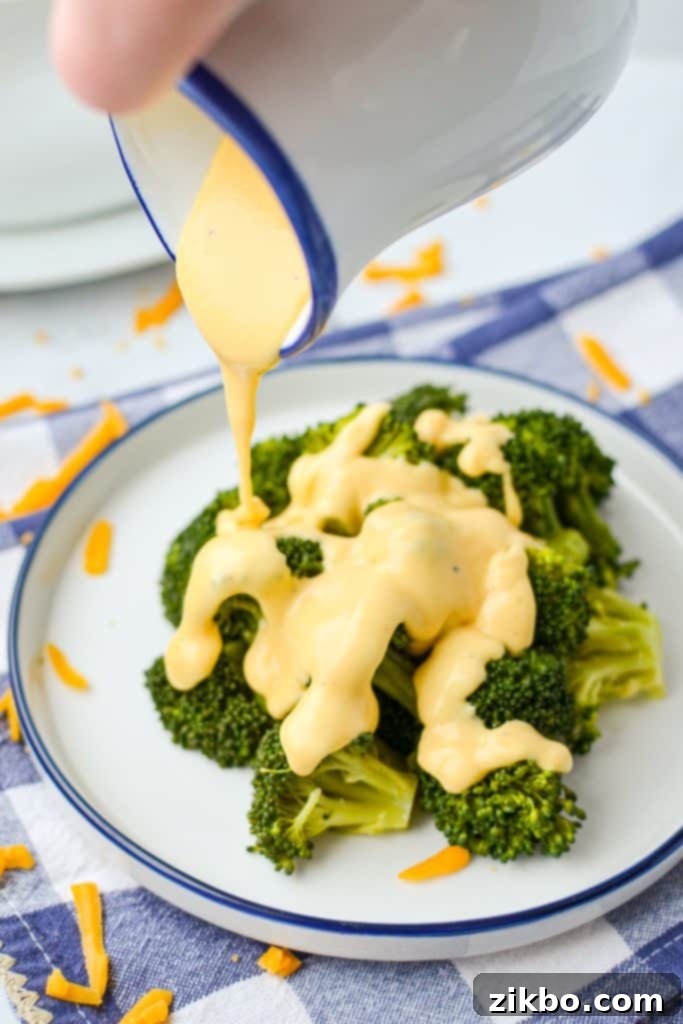
Frequently Asked Questions About Homemade Cheese Sauce
The most common reason for a grainy cheese sauce is using pre-shredded, store-bought cheese. These cheeses are coated with anti-caking agents that don’t melt down smoothly, leading to a gritty texture. Always shred your own cheese from a block for the silkiest results. Another reason can be cooking the cheese at too high a temperature, which causes the proteins to seize and separate. Ensure you remove the sauce from direct heat before stirring in the cheese.
Most traditional homemade cheese sauces, like this recipe, are not gluten-free because they start with a roux made from wheat flour and butter. However, it’s very easy to make it gluten-free by substituting the all-purpose flour with a gluten-free all-purpose flour blend or cornstarch (mixed into a slurry first). Many commercially available cheese sauces might be gluten-free, as they often use cornstarch or other thickeners instead of wheat flour. Always check labels or ask the cook if you have a gluten intolerance.
While you technically can use low-fat milk, it’s not recommended for the best results. Whole milk provides the richness and body necessary for a truly creamy and flavorful cheese sauce. Using skim or low-fat milk may result in a thinner sauce with a less luxurious mouthfeel. If you do use it, you might need to increase the flour slightly to achieve desired thickness or accept a lighter sauce.
If your cheese sauce is too thick, gradually whisk in a tablespoon or two of warm milk (or water) until it reaches your desired consistency. If it’s too thin, you can create a small cornstarch slurry (1 tsp cornstarch mixed with 1 tbsp cold water) and slowly whisk it into the simmering sauce. Let it simmer for another minute or two to thicken. Be careful not to add too much, as cornstarch thickens significantly once heated.
Sauce separation or an oily texture usually happens when the cheese is cooked at too high a temperature, or for too long. Overheating causes the fat to separate from the cheese proteins. To prevent this, always remove the sauce from the heat before adding the shredded cheese, and stir until just melted. If it separates, sometimes adding a teaspoon of cold milk or lemon juice and whisking vigorously can help bring it back together, but it’s often hard to fully recover.
More Cheesy Recipes You’ll Love
- Easy Funeral Potatoes
- English Muffin Pizzas
- Parmesan Crisps
- Baked Feta Pasta
- Layered Salsa Dip
If you loved my Mom’s classic homemade cheese sauce recipe, please let me know by leaving a 5-star review in the recipe card below or sharing your thoughts in the comments! You can also tag me on Instagram @dashfordinner to show off your delicious creations. Your feedback means the world to me!

Mom’s Classic Homemade Cheese Sauce
Print
Pin
Rate
Equipment
-
Heavy bottomed saucepan
-
Whisk
Ingredients
- 3 tablespoons unsalted butter
- 3 tablespoons all-purpose flour
- 2 ½ cups whole milk (cold)
- ¼ teaspoon ground black pepper
- ½ teaspoon dry ground mustard powder
- 2 ½ cups freshly shredded sharp cheddar cheese
- Salt to taste
Instructions
-
Heat a large, heavy-bottomed saucepan over medium heat. Add the butter, swirling it around or whisking to help it melt completely.
-
Once the butter is melted, add the flour to the pot, and whisk it well to combine with the butter, forming a smooth paste (a roux).
-
Cook the roux over medium heat, whisking constantly for 2-3 minutes, until the mixture has started to turn a light blonde color and is slightly bubbly. This cooks out the raw flour taste.
-
Gradually add ½ cup of the cold milk into the roux, whisking vigorously until it is thoroughly combined and forms a very thick, smooth consistency.
-
Continue to add the remaining milk, ½ cup at a time, whisking well after each addition until all the milk is incorporated and the sauce base is smooth.
-
Once all of the milk has been added, stir in the ground black pepper and dry ground mustard powder until well combined.
-
Bring the sauce to a gentle simmer over medium-low heat and allow to cook until thickened, about 2-3 minutes. Stir often to prevent burning or sticking to the bottom.
-
Remove the saucepan from the heat. Add the freshly shredded sharp cheddar cheese. Stir or whisk continuously until the cheese is completely melted and incorporated into a smooth, creamy sauce.
-
Taste the sauce and adjust salt and pepper to your preference.
-
Serve your delicious homemade cheese sauce immediately over vegetables like broccoli or cauliflower, on fries, with pretzels, or as a rich base for homemade macaroni and cheese. Enjoy!
Nutrition
Please note that some of my blog posts here at Dash for Dinner may contain affiliate links. If you make a purchase through these links, I will get a small commission at no additional cost to you. Please see my Disclaimer for more information.
